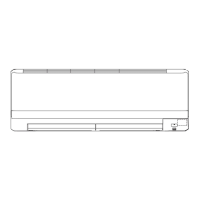Why does the RUN light stay on after stopping my Mitsubishi Heavy Industries SRK50ZJ-S?
- VVictoria SmithSep 6, 2025
The RUN light illuminates during CLEAN operation. The run light turns off when the CLEAN operation ends.

Why does the RUN light stay on after stopping my Mitsubishi Heavy Industries SRK50ZJ-S?
The RUN light illuminates during CLEAN operation. The run light turns off when the CLEAN operation ends.
Why doesn't my Mitsubishi Heavy Industries Air Conditioner restart immediately after being stopped?
The Mitsubishi Heavy Industries Air Conditioner has a built-in delay. Restart is blocked for 3 minutes after you stop it to protect the unit. Please wait for three minutes before restarting.
Why does my Mitsubishi Heavy Industries Air Conditioner blow cold air during heating?
When the outdoor temperature is low and humidity is high, your Mitsubishi Heavy Industries Air Conditioner may automatically defrost. Please wait for the defrosting cycle to complete.
What is the slight gurgling sound from my Mitsubishi Heavy Industries SRK50ZJ-S Air Conditioner?
This sound is caused by refrigerating liquid moving within the Mitsubishi Heavy Industries Air Conditioner unit.
Why is steam escaping from my Mitsubishi Heavy Industries SRK50ZJ-S during COOL operation?
This may occur with your Mitsubishi Heavy Industries Air Conditioner if the room's temperature and humidity are very high. It disappears as soon as the temperature and humidity decrease.
What causes the slight cracking sound in my Mitsubishi Heavy Industries SRK50ZJ-S?
This slight cracking sound from your Mitsubishi Heavy Industries Air Conditioner is caused by heat expansion or contraction.
| Type | Split System |
|---|---|
| Cooling Capacity | 5.0 kW |
| Heating Capacity | 5.8 kW |
| Energy Efficiency Ratio (EER) | 3.21 |
| Coefficient of Performance (COP) | 3.61 |
| Energy Efficiency Rating (Cooling) | A++ |
| Power Supply | 220-240V, 50Hz |
| Outdoor Noise Level | 50 dB(A) |
| Indoor Noise Level | 28 dB(A) |
Important safety guidelines and warnings for installing the air conditioner.
Crucial safety instructions for operating the air conditioner safely.
Specific safety guidelines for moving or repairing the air conditioner unit.
Identification and description of parts within the indoor air conditioner unit.
Identification and description of parts within the outdoor air conditioner unit.
Explanation of remote control indicators and included accessories.
Instructions for replacing batteries in the remote control unit.
Guidance on how to use the provided holder for the remote control.
Troubleshooting steps for when the remote control is not functioning correctly.
How to operate the unit using the manual ON/OFF button when the remote is unavailable.
Details on the buttons and functions available on the remote control's operation section.
How signals are transmitted and the procedure to set the current time.
Automatic selection of COOL, HEAT, or DRY based on room temperature.
How to adjust temperature and fan speed during automatic or other operations.
Instructions for selecting and configuring COOL, HEAT, DRY, and FAN modes.
Recommended operating temperature ranges for various modes to ensure performance.
Explanation of the heating mechanism, capacity, and defrosting process.
How to adjust the airflow direction of the indoor unit using the remote.
How to enable and use the 3D AUTO mode for optimal airflow distribution.
Setting the unit to automatically stop after a set time with temperature adjustment.
Instructions for setting the unit to turn off automatically at a specified time.
Setting the unit to start operation automatically 5 to 60 minutes before a set time.
How to combine SLEEP and ON TIMER functions for sequential operation.
Setting up combined ON and OFF timer operations for daily repetition.
Explanation of the feature that starts operation early for optimal temperature.
How to activate the function to remove allergens from the air.
Description of the HIGH POWER and ECONOMY modes for enhanced or efficient operation.
Procedure to remove moisture and control mold growth inside the indoor unit.
How the unit automatically resumes operation after a power interruption.
Recommendations for economical and comfortable use of the air conditioner.
How to set the unit's location for optimal airflow and conditioning.
How to set the airflow range based on the unit's installation location.
Steps to take before maintenance and during the operational season.
Instructions for cleaning air filters and the air inlet panel.
Tasks to perform at the end and beginning of the operating season for the unit.
Step-by-step guide to installing various types of air-cleaning filters.
Guidance on selecting an appropriate and safe location for installing the unit.
Considerations for minimizing operational noise and vibration during installation.
Steps to diagnose and resolve common problems before calling a technician.
Situations requiring immediate power off and dealer contact for safety issues.
Information on operating multiple air conditioning units simultaneously.
